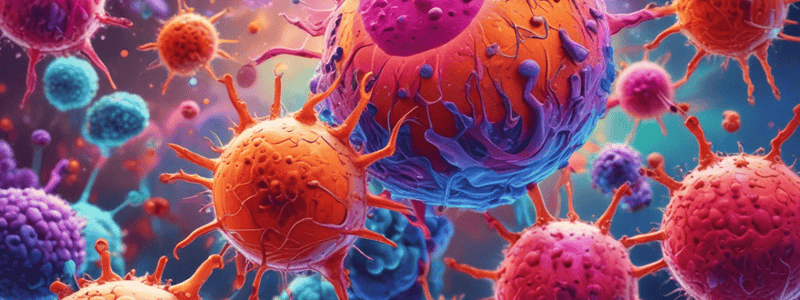Podcast
Questions and Answers
Was ist der Hauptunterschied zwischen angeborener und adaptiver Immunität?
Was ist der Hauptunterschied zwischen angeborener und adaptiver Immunität?
- Angeborene Immunität erfordert Zeit zur Entwicklung, während adaptive Immunität sofortige Abwehr bietet.
- Angeborene Immunität ist spezifisch, während adaptive Immunität unspezifisch ist. (correct)
- Angeborene Immunität bietet lang anhaltende Immunität, während adaptive Immunität kurzfristig ist.
- Angeborene Immunität enthält Gedächtniszellen, adaptive Immunität nicht.
Welche Art von Zellen sind für die Phagozytose von Pathogenen im Immunsystem verantwortlich?
Welche Art von Zellen sind für die Phagozytose von Pathogenen im Immunsystem verantwortlich?
- T-Zellen
- B-Zellen
- Makrophagen und Neutrophile (correct)
- Natürliche Killerzellen
Welche Funktion haben Zytokine im Immunsystem?
Welche Funktion haben Zytokine im Immunsystem?
- Sekretieren Antikörper.
- Erkennen pathogene Muster auf Zellen.
- Koordinieren die Immunantwort durch Signalmoleküle. (correct)
- Eliminieren Virusinfektionen.
Was ist die Hauptfunktion der angeborenen Immunität?
Was ist die Hauptfunktion der angeborenen Immunität?
Welches Element des Immunsystems hilft bei der Erinnerung an frühere Infektionen?
Welches Element des Immunsystems hilft bei der Erinnerung an frühere Infektionen?
Welche Art von Zellen sind für die adaptive Immunität verantwortlich?
Welche Art von Zellen sind für die adaptive Immunität verantwortlich?
Welche Zellen sind an der zellvermittelten Immunität beteiligt?
Welche Zellen sind an der zellvermittelten Immunität beteiligt?
Welche Art von Zellen sind für die Phagozytose von Pathogenen verantwortlich?
Welche Art von Zellen sind für die Phagozytose von Pathogenen verantwortlich?
Was kennzeichnet die adaptive Immunität im Vergleich zur angeborenen Immunität?
Was kennzeichnet die adaptive Immunität im Vergleich zur angeborenen Immunität?
Welche Funktion erfüllen Antikörper bei der Eliminierung von Pathogenen?
Welche Funktion erfüllen Antikörper bei der Eliminierung von Pathogenen?
Welche Zellen sind für die Präsentation von Antigenen an andere Immunzellen verantwortlich?
Welche Zellen sind für die Präsentation von Antigenen an andere Immunzellen verantwortlich?
Flashcards are hidden until you start studying
Study Notes
The Immune System: Innate and Adaptive Immunity, Immune Response, Immune Cells, and Antibodies
Introduction
The immune system is a complex network of cells, proteins, and processes that protect the body from foreign pathogens, such as bacteria, viruses, and parasites. It can be divided into two main lines of defense: innate immunity and adaptive immunity. Innate immunity is the body's first line of defense, providing rapid, non-specific protection against pathogens. Adaptive immunity is a more specialized and targeted response, involving the production of memory cells that remember previous infections and provide long-lasting immunity. In this article, we will explore these immune system components in detail.
Innate Immunity
Innate immunity is a non-specific defense mechanism that provides immediate protection against pathogens. It includes physical barriers like the skin and mucous membranes, as well as physiological defenses such as temperature and low pH. Innate immunity also involves various cells and processes, including:
- Pattern recognition receptors (PRRs): These proteins on immune cells recognize pathogen-associated molecular patterns (PAMPs), which are conserved molecules found in pathogens.
- Phagocytic cells: Cells like macrophages and neutrophils engulf and destroy pathogens.
- Cytokines: These signaling molecules are released by immune cells and help coordinate the immune response.
Adaptive Immunity
Adaptive immunity is a more sophisticated and targeted response to pathogens. It involves the production of antibodies, which are proteins that recognize and bind to specific antigens on the surface of pathogens. This leads to the destruction of the pathogen and the production of memory cells, which can recognize the same pathogen in the future.
Adaptive immunity has two main cell types:
- B cells: These cells produce antibodies that bind to specific antigens.
- T cells: These cells are involved in cell-mediated immunity, where they directly kill infected cells or regulate the immune response.
Immune Response
The immune response is the series of events that occur when the immune system encounters a pathogen. It includes:
- Recognition: The immune system identifies the pathogen through PRRs or through the recognition of antigens by antibodies.
- Activation: Immune cells are activated and begin to produce cytokines, which recruit more immune cells to the site of infection.
- Elimination: Immune cells destroy the pathogen through various mechanisms, such as phagocytosis, complement activation, or cell-mediated cytotoxicity.
- Resolution: The immune response is resolved once the pathogen is eliminated, and memory cells are produced to remember the pathogen for future encounters.
Immune Cells
Key immune cells involved in the immune response include:
- Macrophages: These phagocytic cells engulf and destroy pathogens, as well as present antigens to other immune cells.
- Neutrophils: These cells are also phagocytic and help eliminate bacterial infections.
- Lymphocytes: These cells are responsible for adaptive immunity. They include B cells, which produce antibodies, and T cells, which are involved in cell-mediated immunity.
Antibodies
Antibodies are proteins produced by B cells that recognize and bind to specific antigens on the surface of pathogens. They help eliminate pathogens by marking them for destruction by other immune cells. Antibodies can be classified into isotypes, such as IgG, IgA, and IgE, each with different functions and roles in the immune response.
Conclusion
The immune system is a complex network of cells, proteins, and processes that work together to protect the body from infection. Innate immunity provides rapid, non-specific protection, while adaptive immunity involves the production of memory cells that provide long-lasting immunity to specific pathogens. Key immune cells include macrophages, neutrophils, and lymphocytes, and antibodies play a crucial role in eliminating pathogens. A well-functioning immune system is essential for maintaining health and preventing the spread of infectious diseases.
Studying That Suits You
Use AI to generate personalized quizzes and flashcards to suit your learning preferences.



